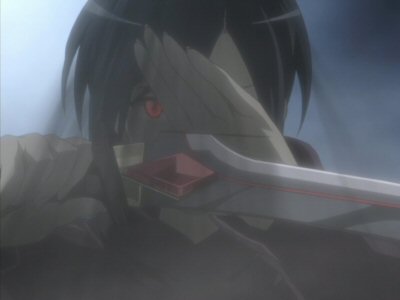
I love this frame—the lighting, the fog, the way Saya’s crimson eye peeks out from behind the triangle formed from her hair, her hand, and the sword. When Blood+ works, there’s no better anime series.
Review by Jay Wilson Had I stopped watching midway through Blood+ to pen this review, you would read an overall lukewarm reaction. The story frequently seems to get distracted with a large cast of characters including the lead protagonist Saya, her family, the Red Shield, the Chevaliers, the Cinq Flèche Corporation, the Schiff, and more. Saya, herself, struggles to remember her past, who and what she is, her fighting potential, and her destiny—admittingly, nice bits of character development—but Blood+ stretches this arc across a painful span of more than a dozen episodes. I love character-driven stories, don’t get me wrong, but instead of dwelling on its characters, Blood+ wavers on the brink of obsessing over them and their issues. Inconsistencies abound, especially in regards to characters arbitrarily seeming invincible until the next encounter where they suddenly have weaknesses. For example: in episodes twenty through thirty, the Chevaliers and Schiff make short work of Saya, and then only a handful of shows later the Schiff plea for Saya’s assistance when faced with a deadly new (more powerful) enemy, the Corpse Corp. Also, once every half-dozen episodes a pointless gunfight breaks out, but only Saya’s blood can destroy the monstrous chiropterans. Sometimes bullets slow the beasts down; sometimes they don’t. It all depends on which characters are in danger and whether or not said characters are expendable. 
Notice the deliberate film-grain in this Vietnam War flashback. Such touches not only give Blood+ a stylistic edge, but also gives the series an eerie sense of authenticity.
But long before any of these faults surfaced, Blood+ introduced the ever sympathetic Saya Otonashi, an innocent girl discovering she’s an otherworldly warrior. And when her eyes turn red after tasting blood, when she unsheathes her katana for the first time and springs into action to Mark Mancina’s adrenaline rush of a score, I knew I was in for something special. Sure, the series would wander into waters I didn’t much care for, but on the promise of those early episodes, I stayed with it. I wanted to stay with Saya. Despite the action-oriented premise—Saya and her sister, Diva, waking from thirty year slumbers to wage war with one another in the world of humans—Blood+ remains forever focused on the characters, their relationships, their unique quirks, and their individual conflicts. We meet her human family, her father George whose looked after her ever since she woke up, full well knowing her true nature; her brothers, Kai and Riku, seek to protect Saya as brothers are want to do, but what can they do against chiropterans? Creatures Saya, and Saya alone, can destroy? Their consciences tell them to be there for her, to stand beside her, yet they only seem to get in the way. And what’s Saya to do but push them away knowing only tragedy can befall anyone who follows her? 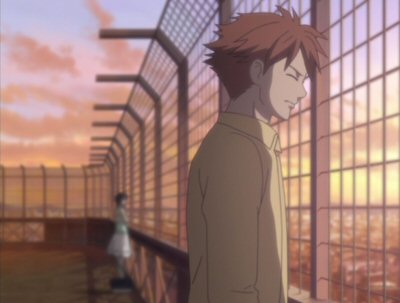
True devotion is staying with someone, knowing they’ve hurt everyone you ever cared about ... knowing they’ll only continue to bring you pain.
Otonashi’s faithful servant, Hagi, left his humanity behind decades ago to become Saya’s Chevalier. But unlike Diva’s Chevaliers, Hagi never takes on his monstrous form as not to upset his mistress. He harbors a long held unspoken love for her, expressing his feelings through quiet, unquestioning, obedience. “When this is all over,” Saya pleads in one of the most potent flashbacks, “I want you to kill me, Hagi.” Her’s and Diva’s conflict have brought unspoken horrors upon the world, and it’s only fitting that in the end she should free the world from her curse. Hagi embraces her and answers, “if that is what you wish ...” ... but in the meantime, he doesn’t hesitate to jump in the line of fire to protect her, swinging his deadly cello case with inhuman speed and grace (you know you’re bad when you fight monsters with a musical instrument.) Should Hagi need to sacrifice himself for his mistress, he won’t hesitate. He’ll obey without question, fear, nor regret. Carl, Diva’s one-armed Chevalier, has an ongoing blood-feud with Saya. In flashbacks we discover he lost his limb to her long ago which fuels an obsession-like lust for revenge. But even though early on he outmatches Saya, he refuses to deliver the killing blow. “You don’t remember yet” he laments and retreats, vowing to finish Saya after she’s regained her memories ... after she comes to full strength. Anything less would be a hollow victory. 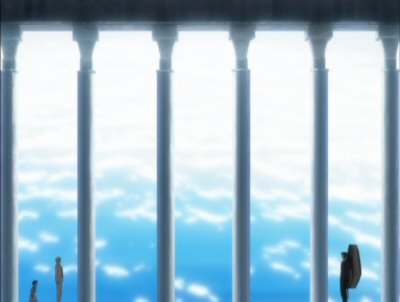
Amidst Saya’s emotional soul searching, Blood+ dares to cut far away to show her, Solomon, and Hagi as tiny insignificant figures in a minimalist frame. Saya feels empty, and this image mirrors that sentiment.
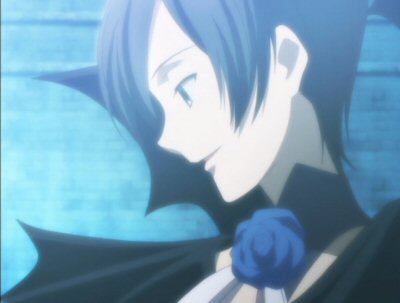
It’s not epic unless it’s opera. Diva’s theme, one of the greatest cues scored for anime, is an aria whose melody begins lonely, cold, and somber and escalates to desperate, hopeless, and tragic ... but not evil. Never evil.
Solomon, another of Diva’s Chevaliers and head of Cinq Flèche Corporation, meets Saya at a dance and falls in love with her before learning her true identity, leading him to go against his fellow Chevaliers and strive for peace between the two sisters ... and ultimately forcing him to choose between his own mistress and her eternal enemy. Does he side with Diva and murder the woman he loves, or does he betray Diva and pursue an impossible love with she who has no reason to trust him (and will Hagi even let him get close?) Along this epic journey, Saya and her companions meet up with experimental sentient chiropterans called the Schiff who broke free from their captivity, but face an artificially shortened lifespan. In Saya’s blood, they see their salvation, and being created as weapons they seek it the only way they know how: via violence. But then a human shows them another way. Of course, more allies stand by to assist Saya. The Red Shield, a secret organization dedicated to the cause of exterminating chiropterans, guide our heroine from location of location, gradually closing in on Diva and her Chevaliers. And, of course, more villains stand to oppose her. Diva’s remaining Chevaliers, Amshall, James, and Nathan each have their own (seemingly conflicting) scheme for Saya’s demise. Van Argeno of Cinq Flèche develops and experiments on chiropterans while staying paradoxically oblivious to the true nature of his research. Then there’s the Corpse Corp, experiments similar to the Schiff minus the self awareness and free will. All are interesting in their own right. I liked David’s deep authorative voice in the English dub; Van Argeno’s obsession with candy; Joel Goldshmidt’s ancestry which dates back to Saya and Diva’s birth, and the tradition of each Goldshmidt generation carrying on the name "Joel" to assume command of the Red Shield. It semi parallels Amshell’s immortality who, like the original Joel, was around for this tale’s true origin. Needless to say, I can go on, for Blood+ meticulously intertwines all of these threads so that each and every major character plays a significant role across these fifty episodes. They’re fascinating in and of themselves, and their dynamic relationships with one another only magnifies that fascination. With so many long-running interesting tangents to deal with, I’m not surprised Blood+ gets side-tracked on occasion. But here’s what’s interesting: though the build-up almost always struck me as mishandled, even frustrating at times, somehow when it came to the payoffs Blood+ delivered. When characters die, the tragedy resonates with a very real sense of loss. When the survivors band together to deal with their sorrow and stay strong together—keep fighting together—it’s touching. And when Saya emerges out of a foggy night to rescue her friends from a pack of chiropterans, Blood+ soars to epic heights leaving the low valleys far behind. 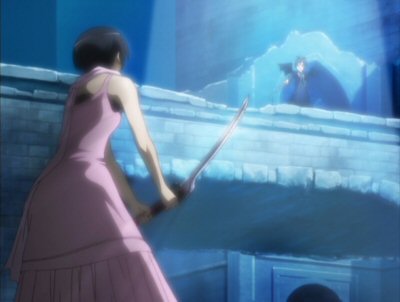
Usually red, an aggressive color, is associated with evil, and blue, a soothing color, is associated with good (think the lightsabers in Star Wars). But I like that Blood+ goes against convention and assigns its villainess the more peaceful color, leaving red to its heroine.
The series has plot problems, yes. Pacing issues, faulty logic, and an almost self-parody habit of characters ominously looking out only to say “Saya” or “Diva.” But you know what? When the two sisters finally stand across from each other, swords dripping with their own blood for the final battle, I’m glad I stayed with Saya. Blood+ truly was something special. | |||||||||||||||||||||||||||||
|
| |||||||||||||||||||||||||||||
